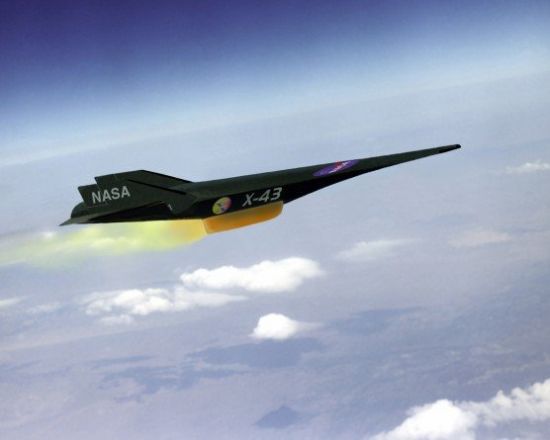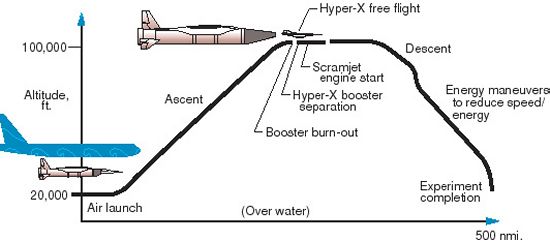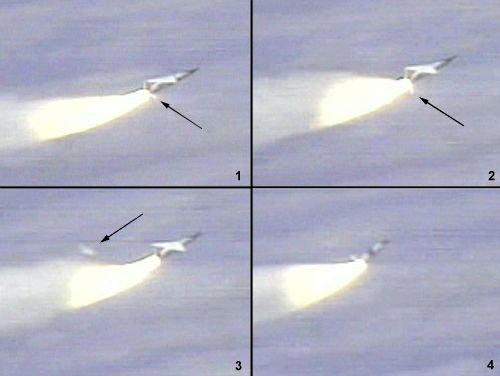|
||||||||||
|
|
||||||||||
|
||||||||||
|
|
||||||||||

While scramjet engines are attractive for flight at speeds of Mach 5 to Mach 25, their biggest drawback is that they must already be in motion before they can begin operating. For this reason, the X-43 is incapable of taking off under its own power but is carried aloft by a B-52 mothership and boosted to high speed by a Pegasus booster rocket, manufactured by Orbital Sciences. This flight profile is illustrated below.

The first X-43 test vehicle was built by Micro Craft, delivered to the NASA Dryden Flight Research Center in southern California, and ready for flight on 2 June 2001. All went according to plan until after the Pegasus/X-43 "stack" was released from the B-52. About 8 seconds after the booster rocket ignited, the stack became unstable and rolled out of control. To prevent any danger to aircraft or inhabited areas, ground controllers were forced to destroy the booster and X-43 using onboard self-destruct explosives. The wreckage fell safely into the Pacific Ocean at the US Navy Sea Range off Point Mugu, California, where the test was being conducted.

Initial investigations of the accident immediately pointed to the booster as being the culprit in the failure. About 5 seconds after booster ignition, parts of the aft end of the Pegasus were observed to break away from the vehicle, and these are believed to be portions of the three tail fins used to control and stabilize the booster (see the "Aft Skirt Assembly" in the above diagram). Without these critical aero-surfaces, the stack became unstable and control could not be recovered. Photos of the fin components detaching during flight are shown below.

It is now believed that this failure was caused by launching the booster at a much lower altitude than it was designed for. Typically, the Pegasus is released at 40,000 ft (12,205 m) and carries a small payload into low Earth orbit (LEO). However, the X-43 was designed to fly at 95,000 to 100,000 ft (28,985 to 30,510 m), so the Pegasus was released at only 24,000 ft (7,320 m) so that it could still fly its standard LEO-type profile to the lower destination altitude. Unfortunately, the atmosphere is much more dense at this lower launch altitude which had the effect of doubling the aerodynamic loads acting on the tail surfaces. The increased forces acting on the fins are believed to have overstressed the surfaces causing them to fail and send the Pegasus out of control.
To ensure that similar failures do not occur on the next two planned X-43 flights, modifications are being made to the intended flight profile as well as the booster. First of all, the stack will be released at 40,000 ft (12,205 m) to better model the flight conditions for which the Pegasus was originally designed. This change also requires that unnecessary propellant be removed from the booster solid rocket motor since less is needed to achieve the target altitude of 95,000 ft. In addition, the booster's tail fin actuators, which move the fins during flight, are being redesigned with larger torque margins to handle the anticipated aerodynamic loads. These modifications have been validated through wind tunnel testing by both Orbital Sciences and the NASA Langley Research Center to verify that the predicted loads on the booster's fin actuator systems are accurate.
Despite these changes, an element of risk is still involved since the planned flight trajectories are much
different than those flown by a standard Pegasus booster. The booster will operate at much lower angles of attack
than usual, especially during the period when the stack levels out to horizontal flight so that the X-43 can
separate to fly under the power of its scramjet engine. Following a two-year delay due to the mishap investigation
and redesign effort, it is hoped that the second X-43 flight test will occur in mid-2003.
- answer by Jeff Scott, 23 March 2003
Related Topics:
Read More Articles:


|
Aircraft | Design | Ask Us | Shop | Search |

|
|
| About Us | Contact Us | Copyright © 1997- | |||
|
|
|||